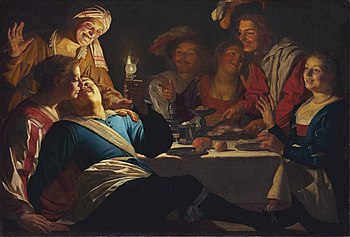
Genre art is the pictorial representation in any of various media of scenes or events from everyday life, such as markets, domestic settings, interiors, parties, inn scenes, work, and street scenes. Such representations may be realistic, imagined, or romanticized by the artist. Some variations of the term genre art specify the medium or type of visual work, as in genre painting, genre prints, genre photographs, and so on.
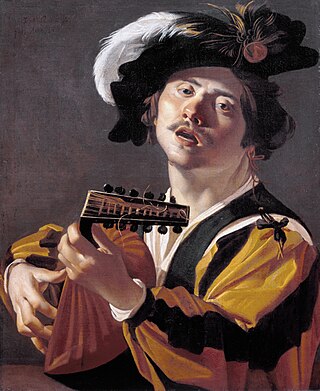
Dirck Jaspersz. van Baburen was a Dutch painter and one of the Utrecht Caravaggisti.

The Caravaggisti were stylistic followers of the late 16th-century Italian Baroque painter Caravaggio. His influence on the new Baroque style that eventually emerged from Mannerism was profound. Caravaggio never established a workshop as most other painters did, and thus had no school to spread his techniques. Nor did he ever set out his underlying philosophical approach to art, the psychological realism which can only be deduced from his surviving work. But it can be seen directly or indirectly in the work of Rubens, Jusepe de Ribera, Bernini, and Rembrandt. Famous while he lived, Caravaggio himself was forgotten almost immediately after his death. Many of his paintings were re-ascribed to his followers, such as The Taking of Christ, which was attributed to the Dutch painter Gerrit van Honthorst until 1990.

Gerard van Honthorst was a Dutch Golden Age painter who became known for his depiction of artificially lit scenes, eventually receiving the nickname Gherardo delle Notti. Early in his career he visited Rome, where he had great success painting in a style influenced by Caravaggio. Following his return to the Netherlands he became a leading portrait painter. Van Honthorst's contemporaries included Utrecht painters Hendrick Ter Brugghen and Dirck van Baburen.

Utrecht Caravaggism refers to the work of a group of artists who were from, or had studied in, the Dutch city of Utrecht, and during their stay in Rome during the early seventeenth century had become distinctly influenced by the art of Caravaggio. Upon their return to the Dutch Republic, they worked in a so-called Caravaggist style, which in turn influenced an earlier generation of local artists as well as artists in Flanders. The key figures in the movement were Hendrick ter Brugghen, Gerrit van Honthorst and Dirck van Baburen, who introduced Caravaggism into Utrecht painting around 1620. After 1630 the artists moved in other directions and the movement petered out. The Utrecht Caravaggisti painted predominantly history scenes and genre scenes executed in a realist style.
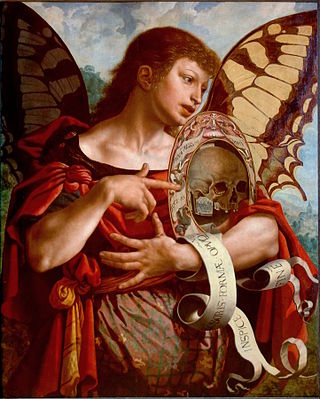
Jan Sanders van Hemessen was a leading Flemish Renaissance painter, belonging to the group of Italianizing Flemish painters called the Romanists, who were influenced by Italian Renaissance painting. Van Hemessen had visited Italy during the 1520s, and also Fontainebleau near Paris in the mid 1530s, where he was able to view the work of the colony of Italian artists known as the First School of Fontainebleau, who were working on the decorations for the Palace of Fontainebleau. Van Hemessen's works show his ability to interpret the Italian models into a new Flemish visual vocabulary.

Judith Jans Leyster was a Dutch Golden Age painter of genre works, portraits, and still lifes. Her work was highly regarded by her contemporaries, but largely forgotten after her death. Her entire oeuvre came to be attributed to Frans Hals or to her husband, Jan Miense Molenaer. In 1893, she was rediscovered and scholars began to attribute her works correctly.

Dutch Golden Age painting is the painting of the Dutch Golden Age, a period in Dutch history roughly spanning the 17th century, during and after the later part of the Eighty Years' War (1568–1648) for Dutch independence.

Genre painting, a form of genre art, depicts aspects of everyday life by portraying ordinary people engaged in common activities. One common definition of a genre scene is that it shows figures to whom no identity can be attached either individually or collectively, thus distinguishing it from history paintings and portraits. A work would often be considered as a genre work even if it could be shown that the artist had used a known person—a member of his family, say—as a model. In this case it would depend on whether the work was likely to have been intended by the artist to be perceived as a portrait—sometimes a subjective question. The depictions can be realistic, imagined, or romanticized by the artist. Because of their familiar and frequently sentimental subject matter, genre paintings have often proven popular with the bourgeoisie, or middle class.

Theodoor Rombouts was a Flemish painter who is mainly known for his Caravaggesque genre scenes depicting lively dramatic gatherings as well as religiously themed works. He is considered to be the primary and most original representative of Flemish Caravaggism. These Caravaggisti were part of an international movement of European artists who interpreted the work of Caravaggio and the followers of Caravaggio in a personal manner.
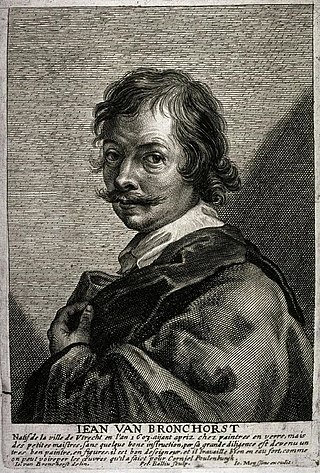
Jan Gerritsz van Bronckhorst was a Dutch Golden Age painter and engraver. He is considered today to be a minor member of the Utrecht Caravaggisti.

Jan Cossiers was a Flemish painter and draughtsman. Cossiers' earliest works were Caravaggesque genre works depicting low life scenes. Later in his career he painted mostly history and religious subjects as well as portraits. Cossiers was one of the leading painters in Antwerp after Rubens' death in 1640 and one of the most original colorists in 17th-century Flanders. He was an accomplished draughtsman who created some sensitive portrait drawings executed in a very varied and fluid manner.

Joos van Craesbeeck (c. 1605/06 – c. 1660) was a Flemish baker and a painter who played an important role in the development of Flemish genre painting in the mid-17th century through his tavern scenes and dissolute portraits. His genre scenes depict low-life figures as well as scenes of middle-class people. He created a few religiously themed compositions.

Matthias Stom or Matthias Stomer was a Dutch, or possibly Flemish, painter who is only known for the works he produced during his residence in Italy. He was influenced by the work of non-Italian followers of Caravaggio in Italy, in particular his Dutch followers often referred to as the Utrecht Caravaggists, as well as by Jusepe de Ribera and Peter Paul Rubens. He did not share the other Northern Caravaggisti's preference for humorous, and sometimes scabrous, genre scenes and elaborate decorative allegories but favored stories from the bible instead. He worked in various locations in Italy where he enjoyed the patronage of religious institutions as well as prominent members of the nobility.
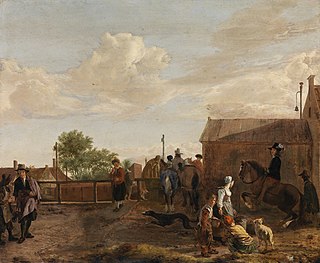
Ludolf de Jongh or Ludolf Leendertsz. de Jongh was a Dutch painter, known for his genre scenes, hunting scenes, history paintings, landscapes, cityscapes and portraits. He was further a merchant, an officer in the civil guard of Rotterdam and a schout (sheriff) of Hillegersberg. He was in the 1650s the leading genre painter in Rotterdam whose work influenced artists such as Pieter de Hooch. He was active as a staffage painter and added the figures in the works of artists such as the church interior painter Anthonie de Lorme and the landscape painter Joris van der Haagen.

Christoffel Jacobsz van der Laemen or Christoffel van der Laemen was a Flemish painter who specialized in merry company scenes with elegant figures. His favorite themes were card and backgammon players, brothel scenes, the prodigal son, dancing, music making and scenes of food and drink set in elegant rooms, inns and gardens.

Joos van Winghe, Jodocus a Winghe or Jodocus van Winghen (1544–1603) was a Flemish painter and print designer. He is known for his history paintings, portraits, allegories and genre scenes, including merry companies. He worked in Brussels as court painter and left Flanders after the Fall of Antwerp in 1584. He then worked in Frankfurt for the remainder of his career. In Germany he enjoyed the patronage of Holy Roman emperor Rudolf II and adopted a more clearly Mannerist style.

The Return of the Prodigal Son is an oil painting by Rembrandt, part of the collection of the Hermitage Museum in St. Petersburg. It is among the Dutch master's final works, likely completed within two years of his death in 1669 . Depicting the moment of the prodigal son's return to his father in the Biblical parable, it is a renowned work described by art historian Kenneth Clark as "a picture which those who have seen the original in St. Petersburg may be forgiven for claiming as the greatest picture ever painted".

Merry company is the term in art history for a painting, usually from the 17th century, showing a small group of people enjoying themselves, usually seated with drinks, and often music-making. These scenes are a very common type of genre painting of the Dutch Golden Age and Flemish Baroque; it is estimated that nearly two thirds of Dutch genre scenes show people drinking.

Smiling Girl, a Courtesan, Holding an Obscene Image, also known in Dutch as Een Laggende Vrouw met een naakte Pourtraitje in de Hand, waar onder divisje staat or Jonge vrouw met een medaillon, is an oil painting on canvas by Gerard van Honthorst, created in 1625. It is held in the Saint Louis Art Museum where it is on view in Gallery 236.
